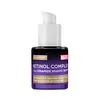What's inside
What's inside
 Key Ingredients
Key Ingredients

 Benefits
Benefits

 Concerns
Concerns

 Ingredients Side-by-side
Ingredients Side-by-side

Water
Skin ConditioningGlycerin
HumectantPropanediol
SolventBakuchiol
AntimicrobialSodium Hyaluronate
HumectantMalus Domestica Fruit Cell Culture Extract
Skin ConditioningLaminaria Digitata Extract
Skin ProtectingCentella Asiatica Extract
CleansingPicea Abies Extract
Skin ConditioningAllantoin
Skin ConditioningAcrylates Crosspolymer
AbsorbentPanax Ginseng Root Extract
EmollientGlycolic Acid
BufferingTetrapeptide-21
Skin ConditioningChlorphenesin
AntimicrobialCaffeine
Skin ConditioningSodium Benzoate
MaskingXanthan Gum
EmulsifyingWater, Glycerin, Propanediol, Bakuchiol, Sodium Hyaluronate, Malus Domestica Fruit Cell Culture Extract, Laminaria Digitata Extract, Centella Asiatica Extract, Picea Abies Extract, Allantoin, Acrylates Crosspolymer, Panax Ginseng Root Extract, Glycolic Acid, Tetrapeptide-21, Chlorphenesin, Caffeine, Sodium Benzoate, Xanthan Gum
Water
Skin ConditioningGlycerin
HumectantRetinol
Skin ConditioningDimethyl Isosorbide
SolventChlorphenesin
AntimicrobialSqualane
EmollientCeteareth-25
CleansingHydroxypinacolone Retinoate
Skin ConditioningCetyl Alcohol
EmollientPolyacrylate Crosspolymer-6
Emulsion StabilisingBehenic Acid
CleansingCholesterol
EmollientCeramide NP
Skin ConditioningCeramide Ns
Skin ConditioningCeramide Eos
Skin ConditioningCeramide EOP
Skin ConditioningCeramide AP
Skin ConditioningCaprooyl Phytosphingosine
Skin ConditioningCaprooyl Sphingosine
Skin ConditioningMannitol
HumectantPhosphatidylcholine
EmulsifyingRetinal
Skin ConditioningPotassium Sorbate
PreservativeSodium Benzoate
MaskingCitric Acid
BufferingSodium Chloride
MaskingWater, Glycerin, Retinol, Dimethyl Isosorbide, Chlorphenesin, Squalane, Ceteareth-25, Hydroxypinacolone Retinoate, Cetyl Alcohol, Polyacrylate Crosspolymer-6, Behenic Acid, Cholesterol, Ceramide NP, Ceramide Ns, Ceramide Eos, Ceramide EOP, Ceramide AP, Caprooyl Phytosphingosine, Caprooyl Sphingosine, Mannitol, Phosphatidylcholine, Retinal, Potassium Sorbate, Sodium Benzoate, Citric Acid, Sodium Chloride
Ingredients Explained
These ingredients are found in both products.
Ingredients higher up in an ingredient list are typically present in a larger amount.
Chlorphenesin is a synthetic preservative. It helps protect a product against bacteria in order to extend shelf life. In most cases, Chlorphenesin is paired with other preservatives such as phenoxyethanol and caprylyl glycol.
Chlorphenesin is a biocide. This means it is able to help fight the microorganisms on our skin. It is also able to fight odor-releasing bacteria.
Chlorphenesin is soluble in both water and glycerin.
Studies show Chlorphenesin is easily absorbed by our skin. You should speak with a skincare professional if you have concerns about using Chlorphenesin.
Learn more about ChlorphenesinGlycerin is already naturally found in your skin. It helps moisturize and protect your skin.
A study from 2016 found glycerin to be more effective as a humectant than AHAs and hyaluronic acid.
As a humectant, it helps the skin stay hydrated by pulling moisture to your skin. The low molecular weight of glycerin allows it to pull moisture into the deeper layers of your skin.
Hydrated skin improves your skin barrier; Your skin barrier helps protect against irritants and bacteria.
Glycerin has also been found to have antimicrobial and antiviral properties. Due to these properties, glycerin is often used in wound and burn treatments.
In cosmetics, glycerin is usually derived from plants such as soybean or palm. However, it can also be sourced from animals, such as tallow or animal fat.
This ingredient is organic, colorless, odorless, and non-toxic.
Glycerin is the name for this ingredient in American English. British English uses Glycerol/Glycerine.
Learn more about GlycerinSodium Benzoate is a preservative. It's used in both cosmetic and food products to inhibit the growth of mold and bacteria. It is typically produced synthetically.
Both the US FDA and EU Health Committee have approved the use of sodium benzoate. In the US, levels of 0.1% (of the total product) are allowed.
Sodium benzoate works as a preservative by inhibiting the growth of bacteria inside of cells. It prevents the cell from fermenting a type of sugar using an enzyme called phosphofructokinase.
It is the salt of benzoic acid. Foods containing sodium benzoate include soda, salad dressings, condiments, fruit juices, wines, and snack foods.
Studies for using ascorbic acid and sodium benzoate in cosmetics are lacking, especially in skincare routines with multiple steps.
We always recommend speaking with a professional, such as a dermatologist, if you have any concerns.
Learn more about Sodium BenzoateWater. It's the most common cosmetic ingredient of all. You'll usually see it at the top of ingredient lists, meaning that it makes up the largest part of the product.
So why is it so popular? Water most often acts as a solvent - this means that it helps dissolve other ingredients into the formulation.
You'll also recognize water as that liquid we all need to stay alive. If you see this, drink a glass of water. Stay hydrated!
Learn more about Water